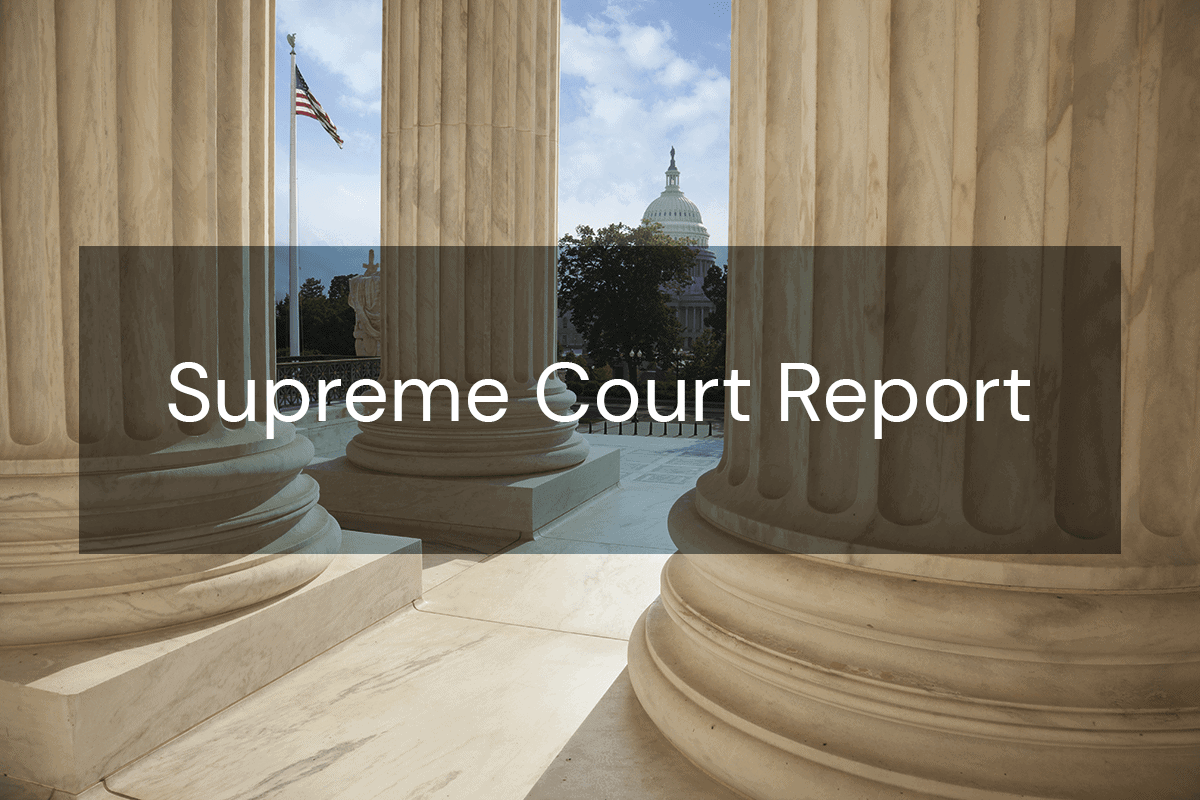-
 Director, Center for Supreme Court AdvocacyNational Association of Attorneys General
Director, Center for Supreme Court AdvocacyNational Association of Attorneys General

Volume 30, Issue 6: This Report summarizes opinions issued on February 22 and 28, 2023 (Part I); and cases granted review on February 27 and March 6, 2023 (Part II).
Opinion: Cruz v. Arizona, 21-846
Cruz v. Arizona, 21-846. By a 5-4 vote, the Court held that the Arizona Supreme Court’s decision denying petitioner John Cruz’s successive postconviction motion as procedurally barred is not an adequate state-law ground for the judgment. In 2005, a jury found Cruz guilty of killing a Tucson police officer. During the aggravation/mitigation stage of his capital trial, Cruz argued that under Simmons v. South Carolina, 512 U.S. 154 (1994), he was entitled to inform the jury that a life sentence carried no possibility of parole. The trial court disagreed, reasoning that Simmons did not apply to Arizona’s capital sentencing scheme. The judge wrongly instructed the jury that one possible penalty was life imprisonment with parole eligibility after 25 years, and the jury sentenced Cruz to death. Four jurors later reported that they would have voted for life without the possibility of parole if that had been an option. Cruz then advanced his Simmons claim on direct appeal, and the Arizona Supreme Court denied relief. Like the trial court, the court determined that Simmons did not apply at Cruz’s trial. After Cruz’s conviction became final, the Court decided Lynch v. Arizona, 578 U.S. 613 (2016) (per curiam), making clear that Simmons applies in Arizona. That prompted Cruz to file a successive postconviction motion under Arizona Rule of Criminal Procedure 32.1(g). Under that rule, a successive petition for postconviction relief is permitted if “there has been a significant change in the law that, if applicable to the defendant’s case, would probably overturn the defendant’s judgment or sentence.” Cruz argued that Lynch was a significant change in the law because it overruled Arizona precedent that prevented capital defendants from informing the jury of their parole ineligibility. The Arizona Supreme Court denied relief, holding that Lynch was not a significant change in the law because “the law relied upon by the Supreme Court in [Lynch]—Simmons—was clearly established at the time of Cruz’s trial . . . despite the misapplication of that law by the Arizona courts.” The court explained that Rule 32.1(g) requires “a significant change in the law, whether state or federal—not a significant change in the application of the law.” In an opinion by Justice Sotomayor, the Court vacated and remanded.
The question before the Court was “whether the Arizona Supreme Court’s holding that Rule 32.1(g) precluded postconviction relief is an adequate and independent state law ground for the judgment.” The general rule is that the Court will not address a question of federal law in a case where the state-court decision rests on a state-law ground that is independent of the federal question and adequate to support the judgment. Focusing on the adequacy requirement, the Court noted that a violation of a state procedural rule that is firmly established and regularly followed typically will be adequate to support the judgment. But in exceptional cases, the Court explained, a “generally sound rule” might be applied in a manner that “renders the state ground inadequate to stop consideration of the federal question.” In particular, “an unforeseeable and unsupported state-court decision on a question of state procedure” is inadequate.
The Court concluded that the Arizona Supreme Court’s decision denying Cruz’s postconviction motion is inadequate because the court applied Rule 32.1(g) in an unforeseeable and unsupported way. Arizona courts have interpreted Rule 32.1(g)’s significant-change-in-the-law phrase to require a “transformative event,” such as an appellate court overruling binding precedent. Given that “Lynch overruled binding Arizona precedent,” the Court determined that the Arizona Supreme Court’s application of Rule 32.1(g) should have been “[s]traightforward.” “Before Lynch,” the court explained, “Arizona courts held that capital defendants were not entitled to inform the jury of their parole ineligibility.” After Lynch, “Arizona courts recognize that capital defendants have a due process right to provide the jury with that information when future dangerousness is at issue.” The Court said, “It is hard to imagine a clearer break from the past.” Yet the Arizona Supreme Court “disregard[ed] the effect of Lynch on the law in Arizona” and instead “considered only whether there had been a significant change in federal law.” For the Court, that approach toward applying Rule 32.1(g) is “entirely new and in conflict with prior Arizona case law” and “thus the opposite of [a] firmly established and regularly followed” practice.
The Court noted that the state’s position created a “catch-22” because under the Arizona Supreme Court’s approach, “it is impossible for Cruz, and similarly situated capital defendants, to obtain relief. To show retroactivity, Cruz argued before the Arizona Supreme Court that Lynch applied ‘settled’ federal law. Under the decision below, however, that same argument implies that Lynch was not a ‘significant change in the law.’” And the Court responded to the dissent’s contention “that this case did present a new context because the Arizona Supreme Court had never before applied Rule 32.1(g) to a summary reversal.” The Court found that this “was no reason . . . to treat this case any differently than past cases. Whereas the Arizona Supreme Court had previously looked to the effect of an intervening federal or state decision on Arizona law, here it focused exclusively on whether there had been a change in federal law. The court thus disregarded that Lynch overruled ‘previously binding case law’ in Arizona, the ‘archetype’ of a significant change in the law.” (Citations omitted.)
Justice Barrett filed a dissenting opinion, which Justices Thomas, Alito, and Gorsuch joined. Justice Barrett argued that “[c]ases of inadequacy are extremely rare, and this is not one.” Justice Barrett noted that “the bar for finding inadequacy is extraordinarily high,” and when “the argument is based on the state court’s inconsistent or novel application of its law, the bar is met only by a decision so blatantly disingenuous that it reveals hostility to federal rights or those asserting them.” Justice Barrett found that the Arizona Supreme Court’s decision does not demonstrate “a purpose or pattern to evade constitutional guarantees” because the court confronted a novel question and “gave an answer reasonably consistent with its precedent.” For support, Justice Barrett pointed to two Arizona Supreme Court decisions addressing Rule 32.1(g)’s significant-change-in-the-law requirement, both of which focused on changes in the content of federal law, as the court did in Cruz’s case. As for the novelty of the Arizona Supreme Court’s “law versus application-of-law distinction,” Justice Barrett submitted that “[n]ovelty does not mean that a rule is inadequate merely because a state court announced it for the first time in the decision under review.” Justice Barrett also maintained that federal habeas draws the same “distinction between a change in the law and a change in the application of the law,” so “we should not be surprised that Arizona has made a similar choice.” At bottom, Justice Barrett found the Arizona Supreme Court’s decision defensible and therefore adequate to support the judgment.



